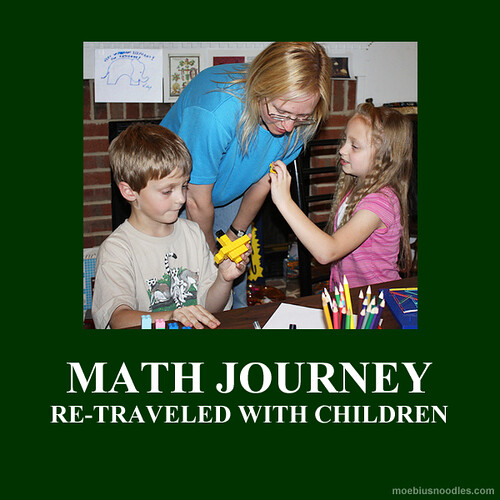Parent roles in a Math Circle
This list is from Julia Brodsky’s upcoming book of Math Circle activities, “The Art of Inquiry.”

Sometimes your group has a leader and kids, and that’s it. But other times, parents or other grown-ups want to join. What will everybody do? Think of their tasks ahead of time. Some are full-time jobs and some only take a few minutes. Here are examples.
Photojournalist takes close-ups of craft stick creations, candid pictures of kids arguing about paradoxes, and group portraits with everyone holding their pictures of infinity. It takes a few minutes for the kids to be used to the camera, then they ignore it. Ask everyone in the group to sign permissions to take photos.
Storyteller knows what activities are planned, but tells the story of what happened. The storyteller can type up a live report on a laptop, or take notes and email the story to everybody later. Good stories are human: they focus on the kids. They capture the excitement of finally finding that last number in a pattern, the hard work of checking all the possibilities, or the healthy frustration of being stuck in a problem. The stories can later be posted online for everyone to read and discuss.
Valorizer finds interesting math in anything kids do. The math may be different from the goals of the activity. But instead of, “This is wrong” the valorizer comments, “This has an interesting symmetry!” or “I like how the pattern grows.” This teaches kids mini-lessons in math, and the big lesson that math is everywhere. The valorizer needs a good eye for math, and an accepting disposition.
Data collector writes down the darndest things kids say, counts how many times kids used math words and what they were, or charts who worked with whom on a project. This can answer your questions and worries, such as, “Do I really address girls more than boys?” or “Is little Johnny learning any terminology?” or “Do kids concentrate better on bouncy balls or chairs?” You can often see a data collector with a rubric or a tally on a clipboard.
Tech assistant helps kids to spell words, to glue or fold paper, to hold a ruler still, and to read problems. The trick is to help kids do what they want, without taking over their math adventures.
Mediator listens to kids if there is a conflict, and helps all sides to tell their stories. Sometimes a kid may be sad, and needs a dedicated adult for company. This is a nurturing role for an active listener. This job is very sporadic, because inquiry makes kids feel good most of the time.
Inspirers usually sit aside but close, in pairs or small groups. It’s a perfect role for someone who mostly wants to observe. Inspirers chat among themselves (quietly) and build a big tiling puzzle, or draw a six-way symmetrical picture, or come up with the funniest paradox – following what children are doing. Kids peek at these more complex, more grown-up versions of their own tasks, and become inspired. Co-working with interested adults creates a good flow.

Posted in Grow
2 comments on “Parent roles in a Math Circle”
Leave a Reply to Sue VanHattum Cancel reply
This site uses Akismet to reduce spam. Learn how your comment data is processed.
MATH ADVENTURES BY EMAIL
Activities, courses, books, and games by and for the Natural Math community.
Books and Goods
Follow
Search
Recent Posts
- Math Maker News: Modultown! by Dec 1, zoo puzzle-hunt, and Future Book Club volunteering November 28, 2025
- A Heart That Continually Grows Forever or Infinitely April 16, 2025
- Summer camps with Pomo and Navajo math friends: June 2024 news July 10, 2024
- Book Clubs and Community-Responsive Math Circles February 7, 2024
- Spring 2023 at FUNDAPROMAT: Calculus for 5-Year-Olds Materials May 14, 2023







I love this list!
“Snack Provider” is also a very important role. :)